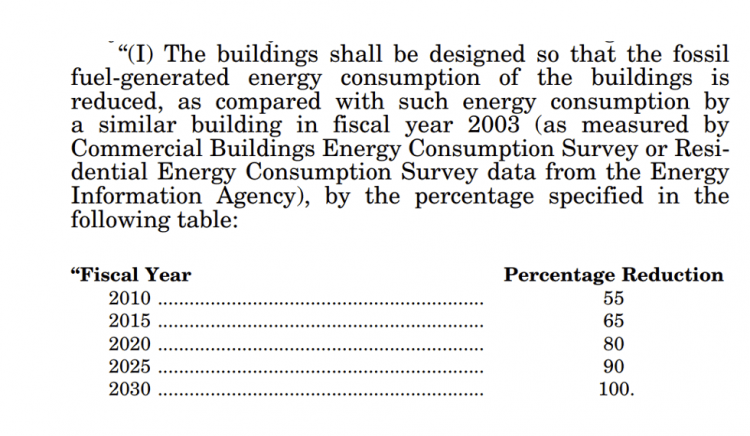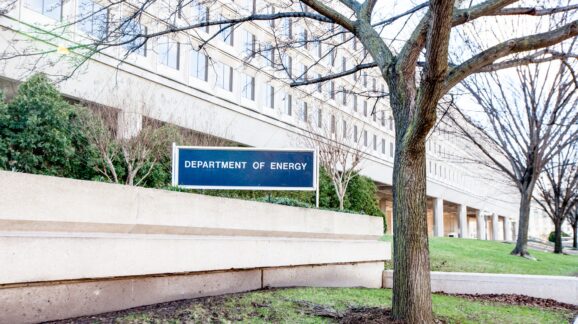The DOE’s Press Release on Federal Building Standards Is Inaccurate and Misleading Puffery
The U.S. Department of Energy (DOE) recently released the pre-publication version of a proposed rule to “establish energy performance standards for the construction of new federal buildings, including commercial buildings, multi-family high-rise residential buildings, and low-rise residential buildings.” DOE’s press release boasts that its “first ever” greenhouse gas (GHG) emission standards for new federal buildings will “save $8 million per year in costs and decrease long-term carbon emissions.” From the release:
Buildings are a major source of greenhouse gas emissions in the U.S., and fossil fuels used in federal buildings account for over 25% of all federal emissions. If enacted within the proposed timeframe, DOE estimates that the new emission reductions requirements would save taxpayers $8 million annually in upfront equipment costs. Over the next 30 years, the new rule would reduce carbon emissions from federal buildings by 1.86 million metric tons and methane emissions by 22.8 thousand tons—an amount roughly equivalent to the emissions generated by nearly 300,000 homes in one year.
The foregoing verbiage is inaccurate and misleading puffery. Let’s start with the “first ever” claim. The proposed energy consumption-reduction standards are a “first” only in the sense that they were previously calibrated in thousands of Btu per square foot and now will also be calibrated in tons of carbon dioxide-equivalent (CO2e) emissions per square foot. The two metrics are mathematically convertible. Compliance with standards calibrated in thousands of Btu/ft2 automatically achieves compliance with the standards calibrated in tons of CO2e/ft2, and vice versa.
There is, however, no “first” in terms of policy substance. Section 433 of the 2007 Energy Independence and Security Act (EISA) requires DOE to adopt rules ensuring that federal buildings constructed or renovated during 2010-2030 meet the following fossil-energy reduction targets compared to similar buildings in 2003:

In short, since 2007, all new federal buildings are required to consume zero Btu of fossil-fuel energy by 2030, which also means zero tons of CO2e emissions.
So, why add a GHG-based metric to a 15-year-old program? Presumably, for the PR value of touting a “new” climate change initiative. But that is laughable, and not only because all the emission reductions were teed up in 2007 under a statute signed into law by President G.W. Bush.
No, what really punctures the balloon is the beyond-puny climate change mitigation DOE’s proposed standards will achieve.
According to the agency’s press release, over the next 30 years, the proposed standards will reduce CO2 emissions from federal buildings by 1.86 million metric tons. What impact would that have on global warming? The U.S. government uses the Model for the Assessment of Greenhouse Gas Induced Climate Change (MAGICC) to calculate the temperature effects of various emission scenarios and mitigation policies. Users can run MAGICC with different estimates of how much long-term warming results from a doubling of atmospheric CO2e concentration—a value known as equilibrium climate sensitivity (ECS).
Here’s a reasonable back-of-the-envelope calculation:
- U.S. annual GHG emissions (CO2e): 6.6 billion tons (2019)
- Assume constant emissions for 30 years: 6.6 x 30 = 198 billion tons
- 1.86 million/198 billion = 0.0000094, or 0.00094 percent
- Assume an ECS of 3 degrees Celsius: MAGICC projects a temperature reduction in 2100 of 0.00001°C
For perspective, the National Oceanic and Atmospheric Administration’s (NOAA) margin of error for measuring changes in global annual average temperature is 0.08°C. The climate mitigation achieved by the proposed standards is orders of magnitude smaller than the margin of error. The rule’s mitigation effects are way too tiny to be detected, measured, or verified.
Actually, the proposed standards will avert even less than 0.0001°C of warming, because the press release is inaccurate. The proposed rule itself nowhere says the standards will avert 1.86 million metric tons (MMT) of “carbon emissions.” Rather, the proposal projects CO2 emissions to increase by 0.2 million tons over the 30-year period, as federal buildings become increasingly reliant on grid-based power for HVAC systems, hot water systems, cooking systems, or other systems or components currently powered by natural gas, diesel, or other on-site fossil fuels.
Read the full article at Real Clear Energy.
